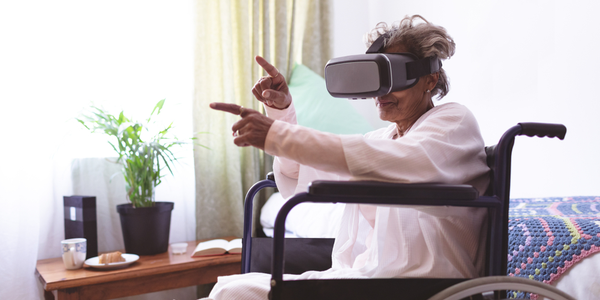Yoga in Fiji? Hike the Grand Canyon? You Can Do it ALL Without Leaving Home

Last month, we shared with you news about the exciting new world of virtual reality (VR) and the numerous health benefits for seniors. But have you considered how VR positively impacts your well-being?
Of course, there are many different ways you can use VR to improve your well-being. Whether you’re just having fun inside the experience, purposefully playing a game or educating yourself on a new topic, there are significant health benefits. Here’s how VR can help you feel better, mind, body and soul.
#1. Mind
VR is just as effective for the mind as the body. By engaging this technology regularly, your brain is making important connections and being exercised in a meaningful way.
Seniors who regularly use virtual reality technology have fewer signs of dementia, and they experience improved cognitive function related to Alzheimer’s. Senior VR users also report improved memory. But these benefits go beyond brain function. Virtual reality improves emotional health, too.
A study on VR use in senior living communities showed that seniors who interact in virtual reality were more relaxed and thought the technology did improve their well-being.
#2. Body
Virtual reality has opened up a whole new world of exercise. Using this technology, you can hike the Grand Canyon, run with the bulls in Pamplona, do yoga on the beach in Fiji or just follow the lead of an instructor in a virtual gym.
That’s the beauty of VR. You can choose to do your workout in a gym-type setting, but you don’t have to. Virtual reality gives you options. You get to choose your fitness experience. And this is important because, for many people, the boredom of the gym prevents them from sticking to a routine.
Seniors who follow a virtual reality workout regime have better balance, posture and motor skills. And if you’re doing cardio or strength training, you’ll probably notice improvements to your stamina and muscle tone, too.
#3. Soul
Loneliness and isolation can affect anyone, even a senior living in a resident community they love. But when you put on that VR headset, you can go anywhere, anytime and do anything! You’re limited by neither time nor space. So visit your childhood neighborhood just as it was when you grew up, get to know a new city where you currently have family or friends or revisit your favorite vacation spot. Whatever you can imagine, you can do.
And you don’t have to do any of these activities alone. Senior living communities that are using VR as a therapeutic tool purchase multiple headsets. That means your friends can join you on your adventures!
Take care
Even though using VR isn’t inherently dangerous, you should be aware of health issues that may affect your experience. Immersive technology can be overwhelming to some users, and seniors with known medical conditions such as epilepsy or heart conditions should consult their doctor before using VR.
If you’re prone to nausea or motion sickness, opt for a slow-paced experience where you remain seated. If you have balance or mobility issues, some VR experiences that require users to move around might not be a good fit for you.
No matter how you choose to use virtual reality, remember, this technology is what you make it. So if you (literally) jump right in and start using VR to exercise your body and mind, you’ll experience positive results. Studies show that seniors who perceive VR to be fun, useful and easy to use have much higher levels of overall enjoyment.
So get out there, put on your goggles and see how VR can improve your body, mind and soul.
image credit: shutterstock/wavebreakmedia
- How Medicare Advantage Plans Cover Seniors’ Vision, Hearing, and Dental Needs - October 29, 2024
- 2025 Medicare Part D Changes: How to Save on Prescriptions - October 25, 2024
- Everything You Need to Know About the 2025 Medicare Changes and How They Affect You - October 21, 2024

